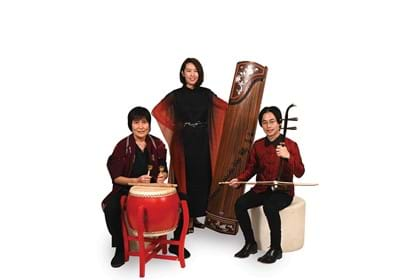“Can you hear it?” Everyone says “Yes!” “OK, so let's sing along...”
The musicians demonstrate how to play the rhythm using actions and body percussion. This use of fine and large motor skills complements cognitive skills to create embodied learning, a concept well-recognised as having positive effects on cognitive skills, well-being and behaviour.*
Then, Satomi uses storytelling to teach the structural concepts, bringing A – B – A or ternary form to life by comparing it to the Samurai practice. During the Edo Period, Japan’s 300 years of peace, she explains, the samurai evolved from martial training into a practice of discipline, respect and responsibility. They performed sword skills as a group, then they took time alone to reflect on their practice, their sword and the way they worked with others.
So in Samurai the first section is in unison, with exciting rhythms and body percussion, but the middle section is more spacious and reflective. The second section is more like a slow movement, where the musicians invite students to improvise and listen to the space around the notes.
‘That's how we start talking about space between people, and how we learn things like echoing and mirroring others,’ says Satomi. ‘Some of the kids are unexpectedly good dancers or improvisers. Some of them are shy but once you get into it everyone gets it.’
At the end of Life is an Echo the musicians share a Japanese tea ceremony, where everyone can stop, breathe, and follow along with Satomi’s simple mime of receiving a cup, admiring a cup, respecting your host, and enjoying tea.
‘We sit and have a cup of tea to appreciate each other’s time together and the distance between each other.’
Then it is time for one last number, and the musicians invite the audience to respond to the music as they will: they can dance, they can move, they can improvise sounds, or they can just find their own space and listen.
‘Each time we reflect on the show to improve it. In fact, doing this show improves us as musicians and as a band, teaches us to respect each other more.'
Life is an Echo tours Victoria and South Australia in Term 2, and Perth in Term 4. If you think your local school might like them to visit, find out more at Musica Viva Australia in Schools.
*Juntunen, Marja-Leena. (2020). Ways to enhance embodied learning in Dalcroze-inspired music education. International Journal of Music in Early Childhood. 15. 39-59. 10.1386/ijmec_00011_1.



